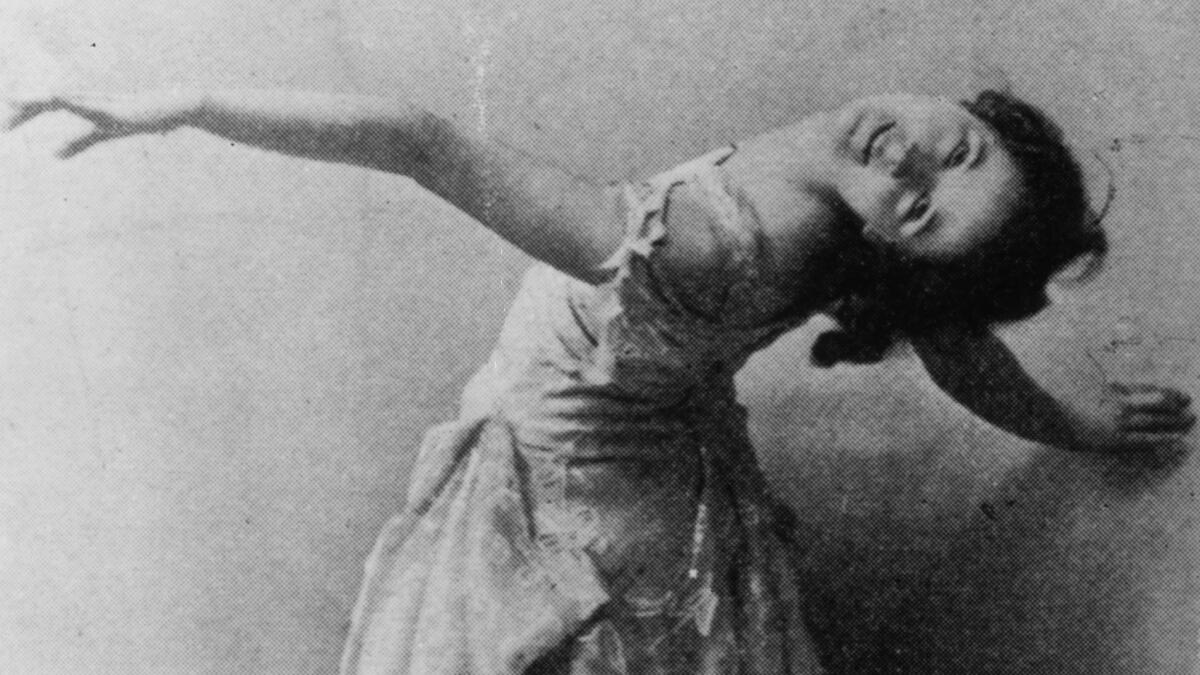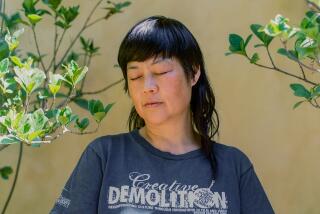Amelia Gray’s ‘Isadora’ is a heavenly celebration of women in charge of their bodies

- Share via
“I have built my life around the feeling of being tipped forward on my toes,” says the mother of modern dance, Isadora Duncan, in the early pages of this biographical novel. At the moment of this reflection, she’s trapped with the bodies of her two children in a room at Père Lachaise Cemetery in Paris, after they drowned in a car that fell into the Seine.
“Isadora” begins with an ending — these true drowning deaths — and plays out as a moment of poise, the feeling of being tipped forward on your toes for almost 400 pages as Isadora teeters on the brink of her sanity and the world teeters on the brink of World War 1. In both the world at large and the world of Isadora Duncan, this was a tense, dense, fertile period, humming with notions about strength, the female body, sovereignty, genius, power, invention and belief. This is a novel about all these things, and also a great novel of character: the story of a real woman’s real grief and survival.
Duncan, of course, really was a character. Born in San Francisco in 1878 (at least, that was one story: her posthumously discovered birth certificate said 1877), she spent her adult life in Western Europe and the Soviet Union, the parts she was and meant, in her own words, “to bring about a great renaissance of religion through the Dance.” There was always some chattering about whether she was quite the genius she believed herself to be. “Isadora is a fascinating dancer, to be certain. But the greatest? In terms of technical skill or invention?” one character asks. To some extent, genius is always a matter of belief, one’s own and others, and if you were a strong-willed woman in the early 20th century, your ambition was as likely to meet scorn as belief. People pored over Duncan’s private life: her children’s deaths, her affairs, her bisexuality, her drinking. She died at age 49 or 50, her glory days well behind her, when her scarf got tangled in the wheel of a car.Amelia Gray’s prose is ideally suited to writing this particular life. As seen in her previous novel, “Threats,” and, particularly, her last short story collection, “Gutshot,” her writing has a carnivorous intensity: The story “Fifty Ways to Eat Your Lover” was a highlight of “Gutshot.”
Gray’s characters devour the world through their senses, a voracious, bodily quality that’s a gift in writing the story of a woman for whom meaning began in the body — who hoped to awaken the world through her own body, no less. In one vision, she imagines: “My students crouch at my feet, filling their cheeks with my bones, chewing toes and knobbly ankles as they try to enter through my veins, to grow strong and vital there before they gnaw their way out.”
Though it uses gifts already apparent in Gray’s work, “Isadora” also marks an evolution: Here, Gray’s prose is enriched by a profound tenderness. “My body is nothing less than an act of faith in the loving world,” says Isadora. In Gray’s earlier writing, the visceral style weirded the world wonderfully; in “Isadora,” it does something more. It insists — much as Duncan herself did — on the body’s primacy in the business of receiving and generating meaning. In particular, it insists on the primacy of the female body, with its capacity for creating life.
This is timely. Since bodies resist recording, history largely omits them — one of history’s main ways of skewing lived events. Considering bodies and the carnivalesque, Russian critic Mikhail Bakhtin wrote: “To ignore or underestimate the laughing people of the Middle Ages also distorts the picture of European culture’s historic development.” Similarly, to ignore the living, dancing bodies of the early 20th century distorts the picture of that time. Perhaps this is why two great literary talents, Zadie Smith and Gray, have recently turned their attention to dance, the most fleeting and bodily and so the most readily forgotten art. In this era of history commandeered by toxic masculinity with delusions of superhumanity, there’s a lot to be said for remembering the truth of the body, particularly the female and otherwise marginalized bodies that are so likely to be written out of the story.
Which is not to say that the body can’t be contentious: In fact, female bodies were the site of much eugenicist scheming during Duncan’s time, and this hums along in the background of “Isadora.” Isadora’s de facto brother-in-law, Max Merz, who ran a dance school with her sister, had his own ideas about the duties of female bodies. Whereas Isadora intended, in the novel’s words, “to find the beauty of life and to express that beauty in the body,” Max has the students performing lunges and lifting weights. “Women should be strong,” he says; imagine “the Blessed Virgin, heavy with child, holding out until they reached a proper town for her to labor on clean linens; think of the order such an action would bestow upon the faith, the progressive sense of comfort.” Merz became a Nazi.
So much, then, for male ideas about female strength. “Isadora” is a heavenly celebration of women in charge of their bodies — though this also means it elides Duncan’s own eugenicist tendencies, which she revealed in offensive comments about jazz, among other things. Gray puts Isadora on the right side of history, giving her one of fiction’s most exquisite dressing-downs for Merz: “You don’t have a bit of philosophy you didn’t scrape off the shoes of greater men, and there is no greater man than me. I am your very own father and mother both, and I hope you never call again.” It’s a glorious moment of character, and also a glorious opportunity to posthumously punch a Nazi, as it were.
All of which is to say nothing of Isadora’s wild tour of Europe as she processes her loss, or of the rich portraits of her family and her lover Paris Singer, heir to the Singer sewing machine fortune. “Isadora” alternates between these characters’ viewpoints in intense bursts: profoundly embodied chapters of a few pages each. Isadora alone speaks in the first person.
Toward the novel’s end, after the assassination of the Archduke Franz Ferdinand, Isadora’s students fret about war. Isadora soothes them: “What you’re feeling, my darling, are the first drumbeats of the artistic revolution, and you and I and your sisters here are the ones leading it. It’s the sound of change, you know.” Of course, Isadora is wrong. It was war. But it might have been the first drumbeats of the artistic revolution too, and if those drumbeats were interrupted by war, Gray reprises them here.
Robins is a writer and translator who lives in Los Angeles.
“Isadora”
By Amelia Gray
Farrar, Straus and Giroux: 400 pp., $27
More to Read
Sign up for our Book Club newsletter
Get the latest news, events and more from the Los Angeles Times Book Club, and help us get L.A. reading and talking.
You may occasionally receive promotional content from the Los Angeles Times.










